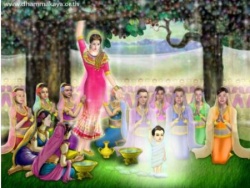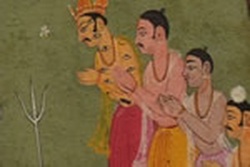Digha Nikaya The Long Discourses
The Digha Nikaya, or "Collection of Long Discourses" (Pali digha = "long") is the first division of the Sutta Pitaka, and consists of thirty-four suttas, grouped into three vaggas, or divisions:
- Silakkhandha-vagga — The Division Concerning Morality (13 suttas)
- Maha-vagga — The Large Division (10 suttas)
- Patika-vagga — The Patika Division (11 suttas)
An excellent modern translation of the complete Digha Nikaya is Maurice Walshe's The Long Discourses of the Buddha: A Translation of the Digha Nikaya (formerly titled: Thus Have I Heard) (Boston: Wisdom Publications, 1987). A fine anthology of selected suttas is Handful of Leaves (Vol. 1), by Thanissaro Bhikkhu (distributed by the Sati Center for Buddhist Studies).
The translator appears in the square brackets []. The braces {} contain the volume and starting page number in the PTS romanized Pali edition.
DN 1: Brahmajāla Sutta — The All-embracing Net of Views {D i 1} Bodhi.
- In this important sutta, the first in the Tipitaka, the Buddha describes sixty-two philosophical and speculative views concerning the self and the world that were prevalent among spiritual seekers of his day. In rejecting these teachings — many of which thrive to this day — he decisively establishes the parameters of his own.
DN 2: Samaññaphala Sutta — The Fruits of the Contemplative Life {D i 47 Thanissaro.
- King Ajatasattu asks the Buddha, "What are the fruits of the contemplative life, visible in the here and now?" The Buddha replies by painting a comprehensive portrait of the Buddhist path of training, illustrating each stage of the training with vivid similes.
DN 9: Potthapada Sutta — About Potthapada {D i 178} Thanissaro.
- The wandering ascetic Potthapada brings to the Buddha a tangle of questions concerning the nature of perception. The Buddha clears up the matter by reviewing the fundamentals of concentration meditation and showing how it can lead to the ultimate cessation of perception.
DN 11: Kevatta (Kevaddha) Sutta — ToKevatta {D i 211} Thanissaro.
- This discourse explores the role of miracles and conversations with heavenly beings as a possible basis for faith and belief. The Buddha does not deny the reality of such experiences, but he points out that — of all possible miracles — the only reliable one is the miracle of instruction in the proper training of the mind. As for heavenly beings, they are subject to greed, anger, and delusion, and so the information they give — especially with regard to the miracle of instruction — is not necessarily trustworthy. Thus the only valid basis for faith is the instruction that, when followed, brings about the end of one's own mental defilements. The tale that concludes the discourse is one of the finest examples of the early Buddhist sense of humor. [This summary provided by the translator.]
DN 12: Lohicca Sutta — To Lohicca {D i 224} Thanissaro.
- A non-Buddhist poses some good questions: If Dhamma is something that one must realize for oneself, then what is the role of a teacher? Are there any teachers who don't deserve some sort of criticism? The Buddha's reply includes a sweeping summary of the entire path of practice.
DN 15: Maha-nidana Sutta — The Great Causes Discourse {D ii 55} Thanissaro.
- One of the most profound discourses in the Pali canon, which gives an extended treatment of the teachings of dependent co-arising (paticca samuppada) and not-self (anatta) in an outlined context of how these teachings function in practice. An explanatory preface is included.
DN 16: Maha-parinibbana Sutta — Last Days of the Buddha/The Great Discourse on the Total Unbinding {D ii 137; chapters 5-6} Vajira/Story | Thanissaro (excerpt)].
- This wide-ranging sutta, the longest one in the Pali canon, describes the events leading up to, during, and immediately following the death and final release (parinibbana) of the Buddha. This colorful narrative contains a wealth of Dhamma teachings, including the Buddha's final instructions that defined how Buddhism would be lived and practiced long after the Buddha's death — even to this day. But this sutta also depicts, in simple language, the poignant human drama that unfolds among the Buddha's many devoted followers around the time of the death of their beloved teacher.
DN 20: Maha-samaya Sutta — The Great Assembly/The Great Meeting {D ii 253} Piyadassi | Thanissaro.
- A large group of devas pays a visit to the Buddha. This sutta is the closest thing in the Pali canon to a "Who's Who" of the deva worlds, providing useful material for anyone interested in the cosmology of early Buddhism.
DN 21: Sakka-pañha Sutta — Sakka's Questions {D ii 276; chapter 2} Thanissaro (excerpt)].
- Sakka, the deva-king, asks the Buddha about the sources of conflict, and about the path of practice that can bring it to an end. This discourse ends with a humorous account about Sakka's frustration in trying to learn the Dhamma from other contemplatives. It's hard to find a teacher when you're a king.
DN 22: Maha-satipatthana Sutta — The Great Frames of Reference {D ii 290} Burma [[Piṭaka] Assn. | Thanissaro.
- This sutta offers comprehensive practical instructions on the development of mindfulness in meditation. The Buddha describes how the development of continuous mindfulness of the four satipatthana ("foundations of mindfulness" or "frames of reference") — mindfulness of the body, of feelings, of the mind, and of mind-objects — can lead ultimately to full Awakening. [The text of this sutta is identical to that of the Satipatthana Sutta (MN 10), except that the Majjhima version omits the exposition of the Four Noble Truths (sections 5a,b,c and d in part D of this version).]
DN 26: Cakkavatti Sutta — The Wheel-turning Emperor {D iii 58} Thanissaro.
- In this excerpt the Buddha explains how skillful action can result in the best kind of long life, the best kind of beauty, the best kind of happiness, and the best kind of strength.
DN 31: Sigalovada Sutta — The Buddha's Advice to Sigalaka/The Discourse to Sigala {D iii 180} [Kelly/Sawyer/Yareham | Narada.
- The householder's code of discipline, as described by the Buddha to the layman Sigala. This sutta offers valuable practical advice for householders on how to conduct themselves skillfully in their relationships with parents, spouses, children, pupils, teachers, employers, employees, friends, and spiritual mentors so as to bring happiness to all concerned.
DN 32: Atanatiya Sutta — Discourse on Atanatiya {D iii 194} Piyadassi.
- One of the "protective verses" (paritta) that are chanted to this day for ceremonial purposes by Theravada monks and nuns around the world. See Piyadassi Thera's The Book of Protection.
Source
"Digha Nikaya: The Long Discourses", edited by Access to Insight. Access to Insight, 7 November 2011, http://www.accesstoinsight.org/tipitaka/dn/index.html . Retrieved on 21 May 2013.


